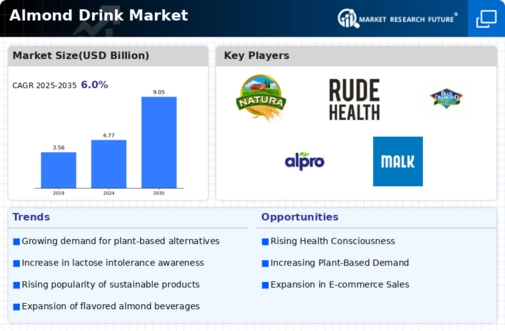Market Analysis
In-depth Analysis of Almond Drink Market Industry Landscape
eGrocery platforms have revolutionized the customer experience by streamlining the grocery delivery process, allowing consumers to easily select preferred delivery slots for timely product delivery. This convenience has significantly impacted various consumer segments influencing the online grocery market, including Gen Z, Millennials, Gen X, and Baby Boomers. These demographic groups, known for their tech-savvy nature, are willing to pay a premium for online services, especially those offering same-day delivery. Gen Z, comprising kids, teens, and young adults born between 1996 and 2010, is a generation deeply connected to the online world due to their upbringing during a period of rapid technological advancement. Their inclination towards online shopping is particularly pronounced, contributing significantly to the online grocery market. Millennials, born between 1981 and 1995, represent a substantial demographic force. With approximately 2.43 billion millennials worldwide, accounting for around 32% of the population according to the World Economic Forum, they are a driving force behind the increasing global demand for online grocery shopping. Their preferences and habits contribute to shaping the market landscape. Gen X, born between 1965 and 1981, is a consumer group that tends to shop across various platforms, displaying a higher willingness to spend, especially on packaged food and beverages driven by impulse purchases. Baby Boomers, individuals born between 1946 and 1964, are recognized as a consumer powerhouse increasingly expressing interest in online shopping. Known for valuing excellent customer service and personal communication, this demographic is an essential target for online sellers who can benefit from offering real representatives for assistance. The expanding consumer pool across these demographics is anticipated to be a significant driver for the growth of the global online grocery market throughout the forecast period. The willingness of these diverse age groups to embrace online grocery shopping, coupled with their increasing reliance on technology, positions them as key contributors to the market's expansion. Another crucial factor propelling the growth of the online grocery market is the increasing per capita disposable incomes. Per capita disposable income represents the income households have after income taxes, available for spending and saving. As per capita disposable incomes rise, consumer buying power increases, leading to a greater willingness to pay for convenient services like online grocery shopping. Developed countries, characterized by healthy economic growth and rising income levels, are pivotal in driving the global online grocery market's growth. The demand for both fresh and packaged food is expected to surge, fueled by the rising middle-class population with heightened expectations, resetting strategic imperatives for industrial manufacturers worldwide. the confluence of factors such as evolving consumer preferences across different age groups and the boost provided by increasing per capita disposable incomes positions the global online grocery market for substantial growth in the forecast period. The convenience and accessibility offered by eGrocery platforms, coupled with the economic factors influencing consumer behavior, indicate a promising trajectory for the online grocery industry.









Leave a Comment